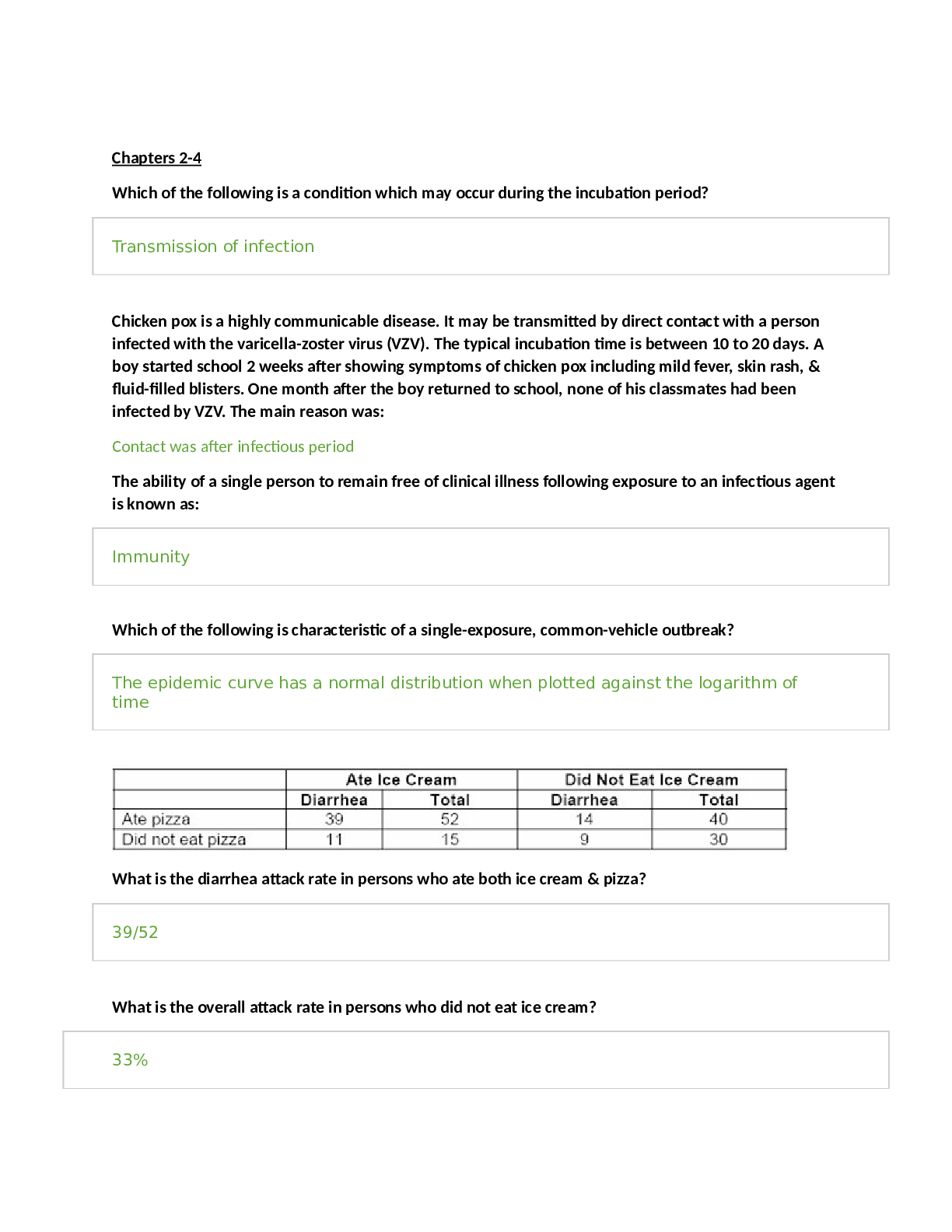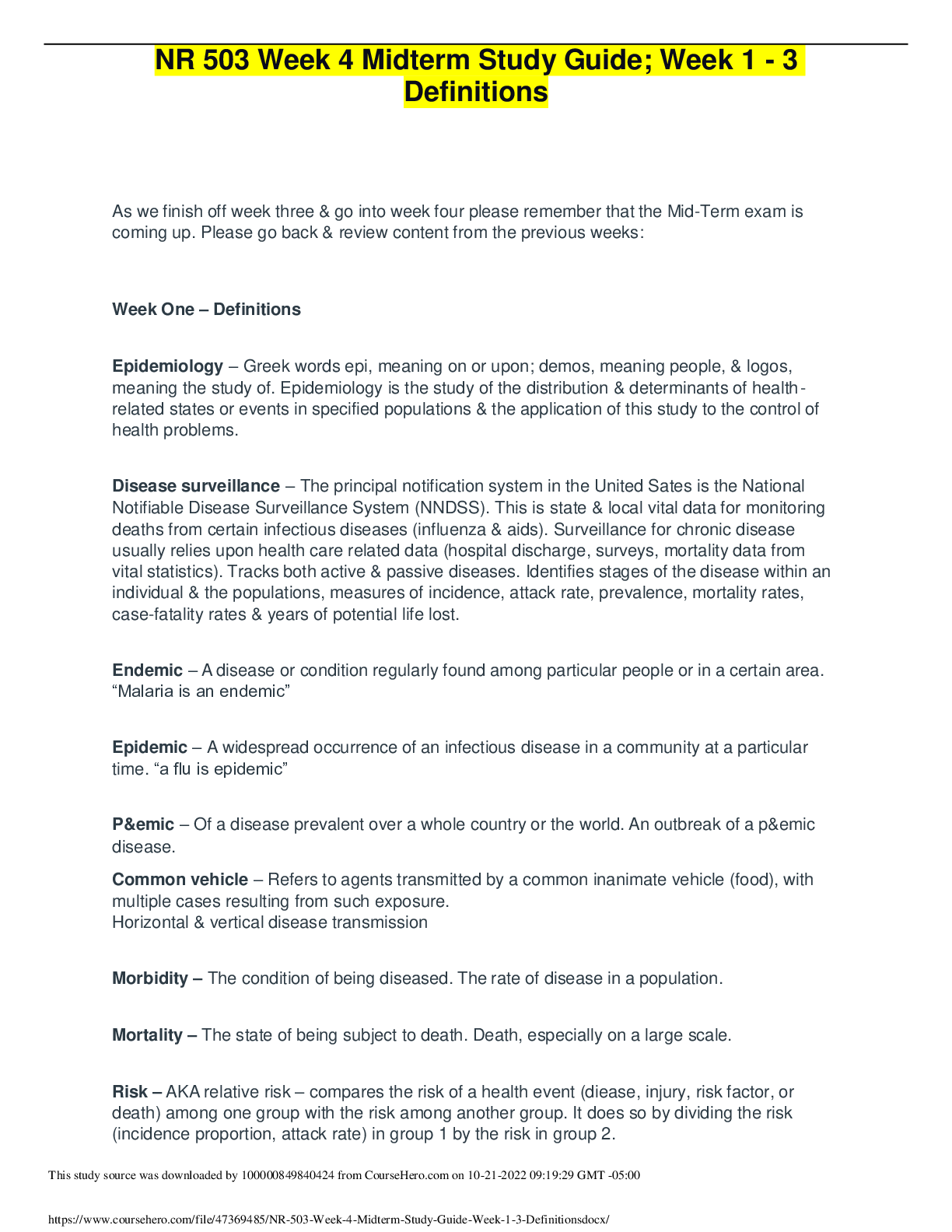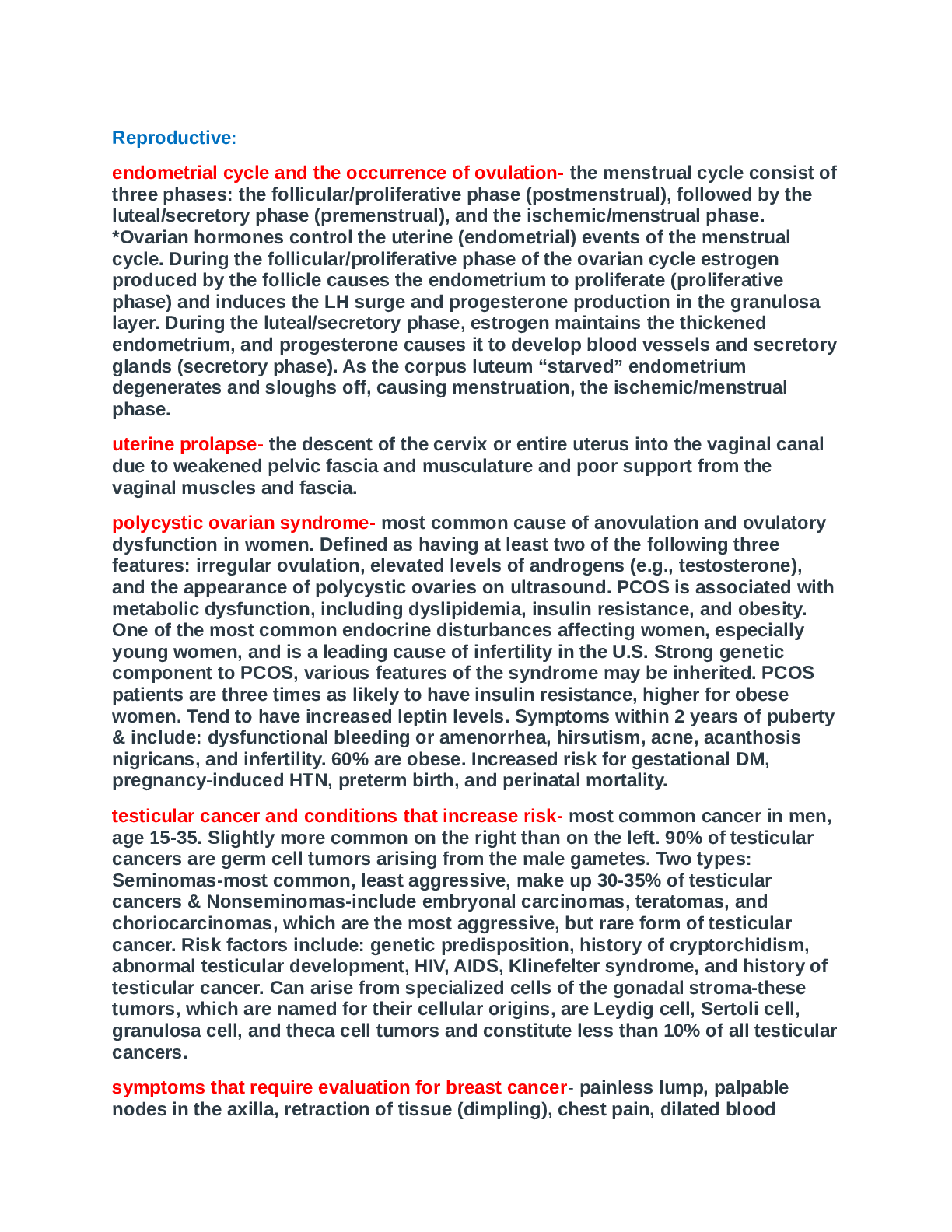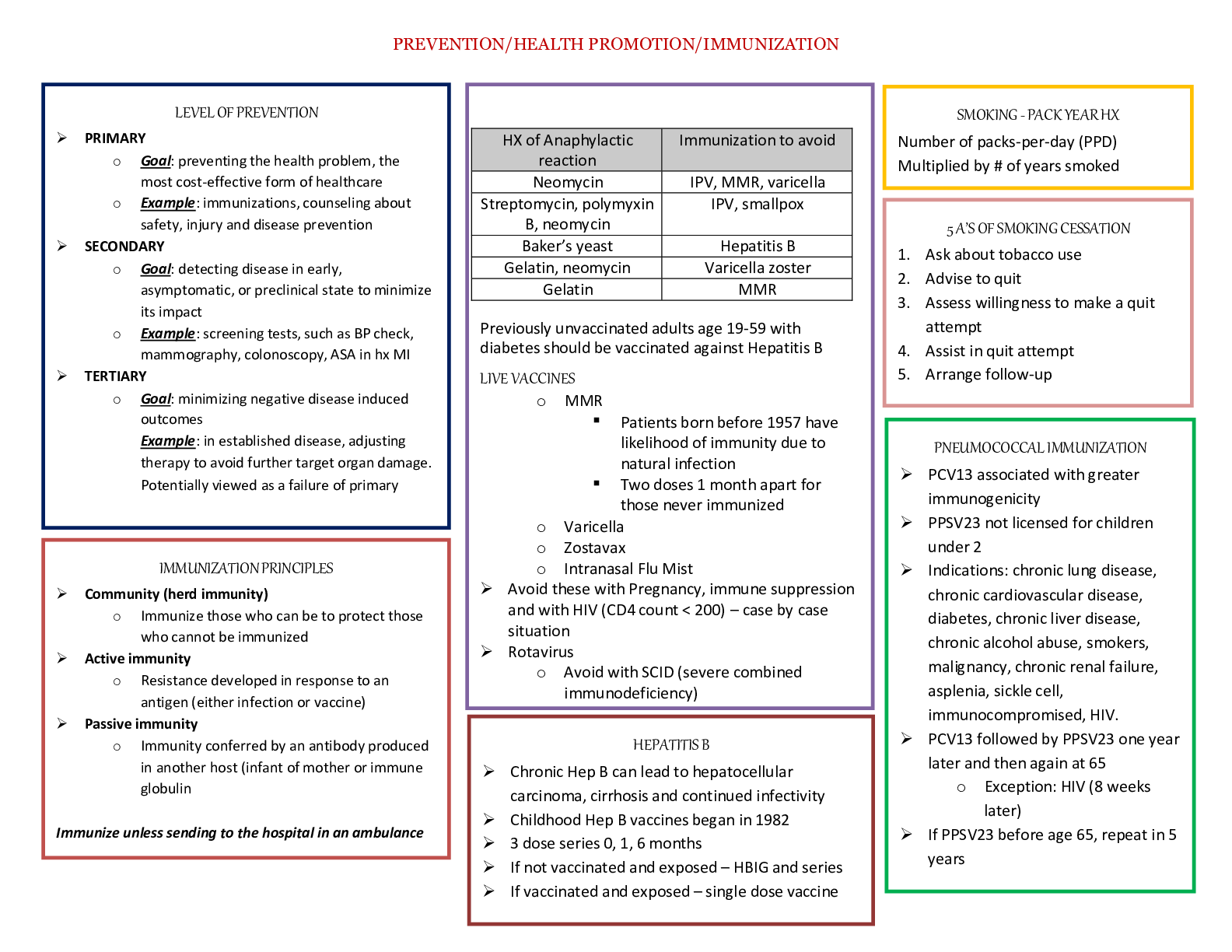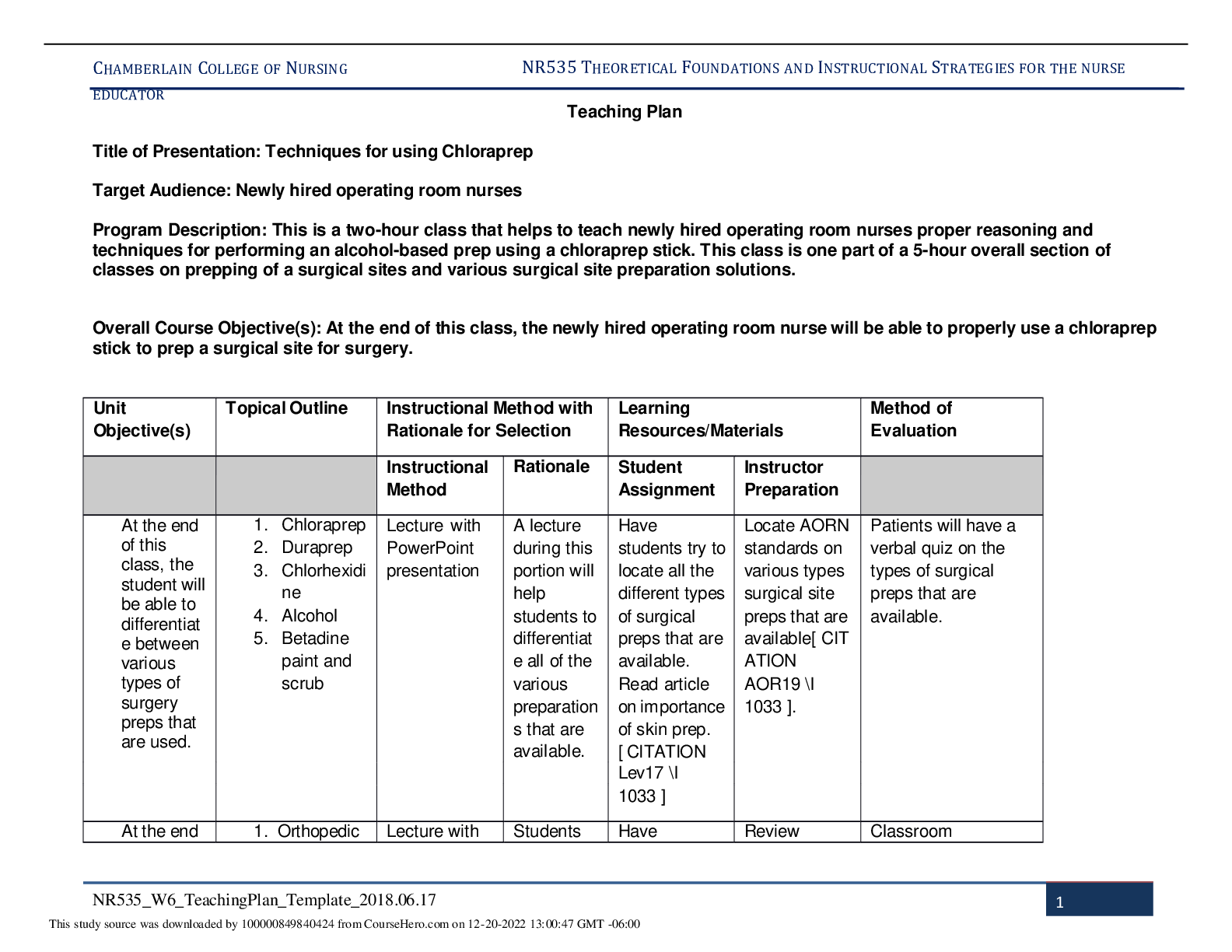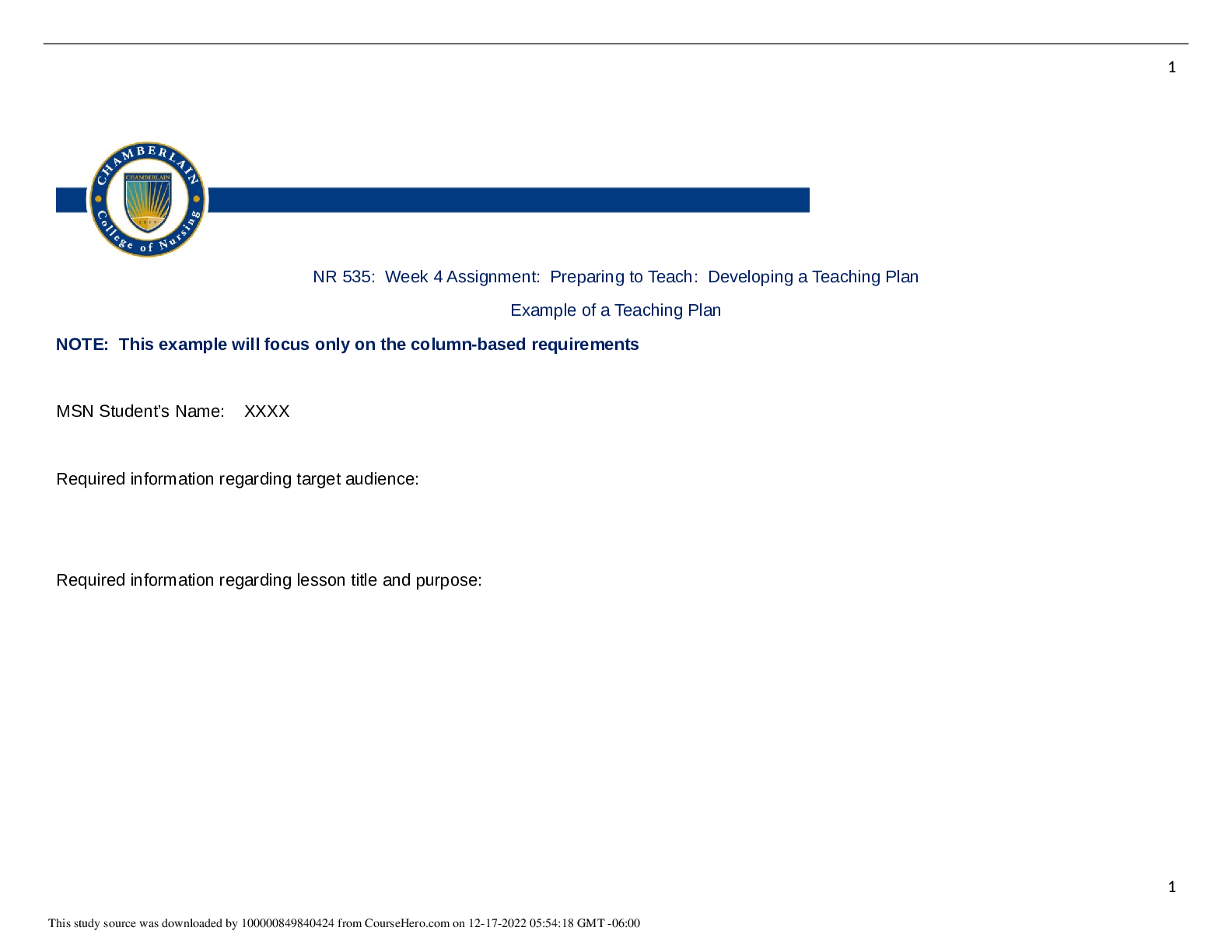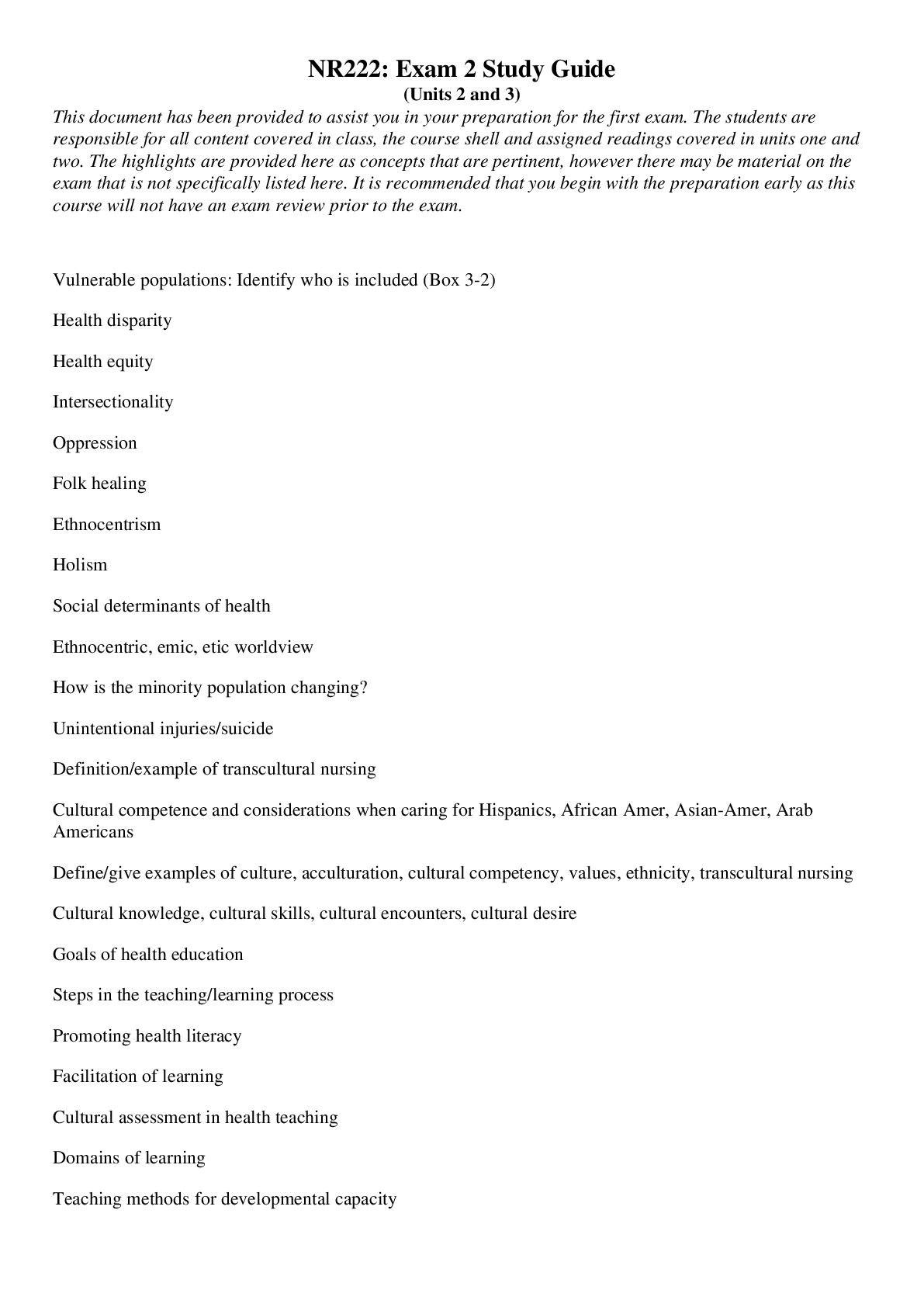*NURSING > STUDY GUIDE > NR 327 Maternity Nursing Hesi Study Guide- Chamberlain College of Nursing (All)
NR 327 Maternity Nursing Hesi Study Guide- Chamberlain College of Nursing
Document Content and Description Below
Maternity Nursing – HESI Hints Anatomy and Physiology of Reproduction • The menstrual phase varies in length in most women • Between ovulation and the beginning of the next menstrual cycle,... there are usually exactly 14 days. In other words, ovulations occurs 14 days before the next menstrual period • Sperm live approximately 3 days (48 to 72 hours), and eggs live about 24 hours. A couple must avoid unprotected intercourse for several days before the anticipated ovulation and for 3 days after ovulation to prevent pregnancy Antepartum Nursing Care • Look for signs of maternal-fetal bonding during pregnancy; for example, talking to fetus in utero, massaging abdomen, and nicknaming fetus are all healthy psychosocial activities • For many women, battering (emotional or physical abuse) begins during pregnancy. Women should be assessed for abuse in private, away from the male partner, by a nurse who is familiar with local resources and knows how to determine the safety of the client. • Practice determining gravidity and parity. A woman who is 6 weeks pregnant has the following maternal history: She has a healthy 2-year old daughter; She has had a miscarriage at 10 weeks; She had an elective abortion at 6 weeks, 5 years earlier; With this pregnancy, she is a gravida 4, para 1 (only one delivery after 20 weeks’ gestation. GTPAL is 4-1-0-2-1. • Practice calculating EDB. If the first day of a woman’s last normal menstrual period was October 17, what is her EDB, using the Nagle Rule? July 24. Count back 3 months and add 7 days (always give February 28 days.) • At approximately 28 to 32 weeks’ gestation, the maximum placenta volume increase of 25% to 40% occurs, resulting in normal hemodilution of pregnancy and Hct values of 32% to 42%. High Hct values may look good, but in reality they represent pregnancy- induced HTN and a depleted vascular space. • Hgb and Hct data can be used to evaluate nutritional status. Example: A 22-year-old primigravida at 12 weeks’ gestation has an Hgb of 9.6 g/dL and an Hct of 31%. She has gained 3 pounds during the first trimester. A weight gain of 2 to 4 pounds during the first trimester is recommended, and this client is anemic. Supplemental iron and a diet higher in iron are needed. • Foods high in iron: Fish and red meats, cereals and yellow vegetables, green leafy vegetables and citrus fruits, egg yolks and dry fruits • As pregnancy advances, the uterus presses on abdominal vessels (vena cava and aorta). Teach the woman that a left side-lying position relieves supine hypotension and increases perfusion to uterus, placenta and fetus. • Fetal well-being is determined by assessing fundal height, fetal heart tones and rate, fetal movement, and uterine activity (contractions). Changes in fetal heart rate are the first and most important indicators of compromised blood flow to the fetus, and these changes require action! Remember, the normal fetal heart rate is 110-160 bpm. • Teach clients to report immediately any of the following danger signs. Early intervention can optimize the maternal and fetal outcome. Possible indications of preeclampsia and eclampsia are: Visual disturbances, swelling of the face fingers or sacrum, severe continuous headache, persistent vomiting, infection (s/s chills, temperature over 100.4, dysuria, abdominal pain), fluid discharge or bleeding from vagina (anything other than normal leukorrhea), change in fetal movement in increased fetal heart rate. • Most providers prescribe prenatal vitamins to ensure that the client receives an adequate intake of vitamins. However, only the health care provider can prescribe prenatal vitamins. It is the nurse’s responsibility to teach about proper diet and about taking prescribed vitamins if they have been prescribed by the health care provider. Fetal and Maternal Assessment Techniques • In some states, screening for neural tube defects by testing either maternal serum alpha- fetoprotein (AFP) levels or amniotic fluid AFP levels is mandated by state law. This screening test is highly associated with both false positives and false negatives. • Gestational age is best determined by an early sonogram rather than a later one. • When an amniocentesis is done in early pregnancy, the bladder must be full to help support the uterus and help push the uterus up in the abdomen for easy access. When an amniocentesis is done in late pregnancy, the bladder must be empty so it will not be punctured. • Early decelerations, caused by head compression and fetal descent, usually occur between 4 and 7 cm and in the second stage of labor. Check for labor progress if early decelerations are noted. • If cord prolapse is detected, the examiner should position the mother to relieve pressure on the cord (i.e. knee-chest position) or push the presenting part off the cord until immediate cesarean delivery can be accomplished. • Late decelerations indicate uteroplacental insufficiency and are associated with conditions such as postmaturity, preeclampsia, DM, cardiac disease, and abruption placentae. • When deceleration patterns (late or variable) are associated with decreased or absent variability and tachycardia, the situation is ominous (potentially disastrous) and requires immediate intervention and fetal assessment • A decrease in uteroplacental perfusion results in late decelerations; cord compression results in a pattern of variable decelerations. Nursing interventions should include changing maternal position, discontinuing Pitocin infusion, administering oxygen, and notifying the healthcare provider. • The danger of nipple stimulation lies in controlling the “dose” of oxytocin delivered by the posterior pituitary. The chance of hyperstimulation or tetany (contractions over 90 seconds or contractions with less than 30 seconds in between) is increased. Intrapartum Nursing Care • Be able to differentiate between true labor and false labor: • TRUE labor: Pain in lower back that radiates to abdomen, pain accompanied by regular rhythmic contractions, contractions that intensify with ambulation, progressive cervical dilation and effacement • FALSE labor: Discomfort localized in abdomen, no lower back pain, contractions decreased in intensity or frequency with ambulation • It is important to know the normal findings for a client in labor: • Normal FHR in labor: 110-116 bpm • Normal maternal BP: <140/90 mmHg • Normal maternal HR: <100 bpm • Normal maternal temperature: <100.4 F • Slight elevation in temperature may occur because of dehydration and the work of labor. Anything higher indicates infection and must be reported immediately. • If infant’s head is floating, watch for cord prolapse. • Meconium-stained fluid is yellow-green or gold-yellow and may indicate fetal distress. • Breathing techniques, such as deep chest, accelerated, and cued, are not prescribed by the stage and phase of labor but by the discomfort level of the laboring woman. If coping is decreasing, switch to a new technique. • Hyperventilation results in respiratory alkalosis that is caused by blowing off too much CO2. Symptoms include: Dizziness, tingling of fingers, stiff mouth; have woman breathe into her cupped hands or a paper bag in order to rebreathe CO2. • Determine cervical dilation before allowing client to push. Cervix should be completely dilated (10 cm) before the client begins pushing. If pushing starts too early, the cervix can become edematous and never fully dilate. • Give the oxytocin after the placenta is delivered because the drug will cause the uterus to contract. If the oxytocic drug is administered before the placenta is delivered, it may results in a retained placenta, which predisposes the client to hemorrhage and infection. • Never give Methergine or Hemabate to a client while she is still in labor or before delivery of the placenta. • Application of perineal pads after delivery: Place two pads on the perineum, do not touch inside of pad, do apply from front to back, being careful not to drag pad across the anus • Full bladder is one of the most common reasons for uterine atony or hemorrhage in the fist 24 hours after delivery. If the nurse finds the fundus soft, boggy, and displaced above and to the right of the umbilicus, what action should be taken first? First, perform fundal massage; then have the client empty her bladder. Recheck fundus every 15 minutes for 1 hour, then every 30 minutes for 2 hours. • If narcotic analgesics (codeine, meperidine) are given, raise side rails and place call light within reach. Instruct cline not to get out of bed or ambulate without assistance. Caution client about drowsiness as a side effect. • A first-degree tear involves only the epidermis. A second-degree tear involves dermis, muscle, and fascia. A third-degree tear extends into the anal sphincter. A fourth-degree tear extends up the rectal mucosa. Tears cause pain and swelling. Avoid rectal manipulations. • If it was documented that the fetus passed meconium in utero or the nurse noted late passage of meconium in the delivery room, the neonate must be attended to by a pediatrician, a neonatologist, or nurse practitioner to determine, through endotracheal tube observation and suction, whether meconium is present below the vocal cords. Such a presence can result in pneumonitis and meconium aspiration syndrome, which necessitate a sepsis workup, including a chest radiograph early in the transitional newborn period. • IV administration of analgesics is preferred to IM administration for a client in labor because the onset and peak occur more quickly, and the duration of the drug is shorter. It is important to know the following: • IV administration: Onset – 5 minutes; Peak – 30 minutes; Duration – 1 hour • IM administration: Onset – within 30 minutes; Peak – 1 to 3 hours after injection; Duration – 4 to 6 hours • Tranquilizers (ataractics and phenothiazines), such as Phenergan and Vistaril, are used in labor as analgesic-potentiating drugs to decrease the amount of narcotic needed and to decrease maternal anxiety. • Agonist narcotic drugs (Demerol, morphine) produce narcosis and have a higher risk for causing maternal and fetal respiratory depression. Antagonist drugs (Stadol, Nubain) have less respiratory depression but must be used with caution in a mother with preexisting narcotic dependency because withdrawal symptoms occur immediately. • Pudendal block and subarachnoid (saddle) block are used only in the second stage of labor. Peridural and epidural blocks may be used during all stages of labor. • The first sign of a block’s effectiveness is usually warmth and tingling in the ball of foot or big toe. • Stop continuous infusion at end of stage I or during transition to increase effectiveness of pushing. Normal Puerperium (Postpartum) • Normal leukocytosis of pregnancy averages 12,000 to 15,000mm. During the first 10-12 days postdelivery, values of 25,000mm are common. Elevated WBC and the normal elevated ESR may confuse interpretation of acute postpartal infections. For example, if the nurse assesses a client’s temperature to be 101 F on the client’s second postpartum day, what assessments should be made before notifying the physician? Assess fundal height and firmness; assess perineal integrity; check for appositive Homan sign and other symptoms of thromboembolism; assess pulse, respirations and BP’ assess client’s subjective description of symptoms (e.g. burning on urination, pain in the leg excessive tenderness of the uterus). • Client and family teaching is a common subject of NCLEX-RN questions. Remember that when teaching, the first step is to assess the client’s (parents’) level of knowledge and to identify their readiness to learn. Client teaching regarding lochia changes, perineal care, breastfeeding, and sore nipples are subjects that are commonly tested. • After the first postpartum day, the most common cause of uterine atony is retained placental fragments. The nurse must check for the presence of fragments in lochial tissue. • Women can tolerate blood loss, even slightly excessive blood loss, in the postpartal period because of the 40% increase in plasma volume during pregnancy. In the postpartal period, a woman can void up to 3000 mL/day to reduce the volume increase that occurred during pregnancy. • Client should void within 4 hours of delivery. Monitor client closely for urine retention. Suspect retention if voiding is frequent and <100 mL per voiding. • Women often have a syncopal (fainting) spell on the first ambulation after delivery (usually related to vasomotor changes, orthostatic hypotension). The astute nurse will check client’s Hgb and Hct for anemia and BP, sitting and lying down, to ascertain orthostatic hypotension. • Kegel exercises increase the integrity of the introitus and improve urine retention. Teach client to alternate contraction and relaxation of the pubococcygeal muscles. • Remember, RhoGAM is given to an Rh-negative mother who delivers and Rh-positive fetus that has a negative direct Coombs test. If the mother has a positive Coombs test, there is no need to give RhoGAM because the mother is already sensitized. • Because Rh immune globulins suppress the immune system, the client who receives both RhoGAM and the rubella vaccine should be tested for rubella immunity at 3 months. • Assess for thromboembolism: Examine legs of a postpartum client daily for pain, warmth, tenderness or a swollen vein that is tender to the touch. Client may or may not exhibit a positive Homan sign (dorsiflexion of foot causes compression of tibial veins and pain if thrombus is present). • “Postpartum blues” are usually normal, especially 5 to 7 days after delivery (unexplained tearfulness, feeling down and having a decreased appetite). Encourage use of support persons to help with housework for first 2 postpartum weeks. Refer to community resources. The Normal Newborn • Physical assessment: A detailed physical assessment is performed by the nurse or physician. Regardless of who performs the physical assessment, the nurse must know normal versus abnormal variations in the newborn. Observations must be recorded and the physician notified regarding abnormalities. • It is difficult to differentiate between caput succedaneum (edema under the scalp) and cephalhematoma (blood under the periosteum). The caput crosses suture lines and is usually present at birth, whereas the cephalhematoma does not cross the suture lines and manifests a few hours after birth. The danger of cephalhematoma is increased hyperbilirubinemia due to excess RBC breakdown. • The umbilical cord should always be checked at birth. It should contain three vessels: one vein, which carries oxygenated blood to the fetus, and two arteries, which carry unoxygenated blood back to the placenta. This is the opposite of normal circulation in the adult. Cord abnormalities usually indicated cardiovascular or renal abnormalities. • Postnatally, the fetal structures of foramen ovale, ductus arteriosus, and ductus vernosus should close. If they do not, cardiac and pulmonary compromise will develop. • Circumcision has become controversial because there is no real medical indication for the procedure, and it does cause trauma and pain to the newborn. It was once thought to decrease the incidence of penile and cervical cancer, but some researchers say this is unfounded. • Hypothermia (heat loss) leads to depletion of glucose and, therefore, to the use of brown fat (special fat deposits fetus develops in last trimester; they are important to thermoregulation) for energy. This results in ketoacidosis and possible shock. Prevent by keeping neonate warm! • Physiologic jaundice occurs at 2-3 days of life. If it occurs before 24 hours of persists beyond 7 days, it becomes pathologic. Typically, NCLEX-RN questions ask about the normal problem of physiologic jaundice, which occurs 2-3 days after birth due to the immature liver’s normal inability to keep up with RBC destruction and to bind bilirubin. Remember, unconjugated bilirubin is the culprit. • To evaluate exact urine output, weigh dry diaper before applying. Weigh the wet diaper after infant has voided. Calculate and record each gram of added weight as 1 mL of urine. • Do not feed a newborn when the respiratory rate is over 60. Inform the physician and anticipate gavage feedings in order to prevent further energy utilization and possible aspiration. • A 7lb 8oz baby would need 50 calories x 7lb = 350 calories plus 25 calories (1/2lb or 8oz) = 375 calories per day. Most infant formulas contain 20 calories per oz. Dividing 375 by 20 = 18.75oz of formula needed per day. • Teach parents to take infant’s temperature, both axillary and rectal. Axillary is recommended, but some pediatricians request a rectal (core) temperature. • Axillary: Place thermometer under infant’s arm and hold thermometer in place for 5 minutes. • Rectal: Use thermometer with blunt end. Insert thermometer ¼ to ½ inch and hold in place for 5 minutes. Hold feet and legs firmly. [Show More]
Last updated: 2 years ago
Preview 1 out of 6 pages
 (1).png)
Buy this document to get the full access instantly
Instant Download Access after purchase
Buy NowInstant download
We Accept:

Reviews( 0 )
$6.50
Can't find what you want? Try our AI powered Search
Document information
Connected school, study & course
About the document
Uploaded On
May 29, 2021
Number of pages
6
Written in
Additional information
This document has been written for:
Uploaded
May 29, 2021
Downloads
0
Views
168


